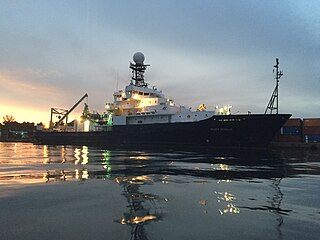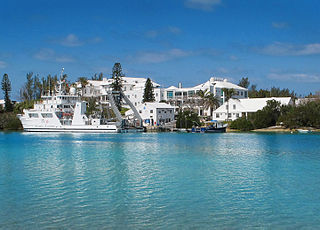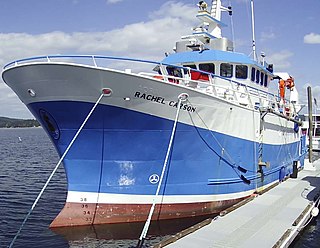
A research vessel is a ship or boat designed, modified, or equipped to carry out research at sea. Research vessels carry out a number of roles. Some of these roles can be combined into a single vessel but others require a dedicated vessel. Due to the demanding nature of the work, research vessels may be constructed around an icebreaker hull, allowing them to operate in polar waters.

BRP Gregorio Velasquez was built by the United States Navy as USNS Melville (T-AGOR-14) for university support of Navy programs. The ship was operated as the research vessel R/V Melville by the Scripps Institution of Oceanography for oceanographic research. As the R/V Melville, it was the oldest active vessel in the academic research fleet, collectively known as the University-National Oceanographic Laboratory System (UNOLS) (UNOLS). The US Government confirmed on 17 November 2015 that the Melville was to be transferred to the Philippine Navy as Excess Defense Articles (EDA)s. The vessel was officially transferred to the Philippines on 28 April 2016 and was commissioned into active service at the same time with the Philippine Navy.

RV Atlantis is a Thomas G. Thompson-class oceanographic research ship, owned by the US Navy and operated by the Woods Hole Oceanographic Institution as part of the University-National Oceanographic Laboratory System (UNOLS) fleet. She is the host vessel of DSV Alvin. She is named for the first research vessel operated by WHOI, the sailboat RV Atlantis, for which the Space ShuttleAtlantis is also named.

RV Knorr was a research vessel formerly owned by the U.S. Navy and operated by the Woods Hole Oceanographic Institution for the U.S. research community in coordination with and as a part of the University-National Oceanographic Laboratory System (UNOLS) fleet. On March 14, 2016, Knorr was officially transferred to the Mexican Navy and renamed Rio Tecolutla. She was replaced at Woods Hole by the RV Neil Armstrong. Knorr is best known as the ship that supported researchers as they discovered the wreck of the RMS Titanic in 1985. R/V Knorr (AGOR-15) has traveled more than a million miles—the rough equivalent of two round trips to the Moon or forty trips around the Earth. Her sister ship is the RV Melville.

R/V Oceanus is a Regional Class research vessel owned by the National Science Foundation, based in Newport, Oregon, and maintained and operated by Oregon State University. The ship was originally delivered to the Woods Hole Oceanographic Institution (WHOI) for operation as a part of the U.S. Academic Research Fleet as a University-National Oceanographic Laboratory System (UNOLS) designated operator. in November, 1975. Oceanus made the first operational cruise in April, 1976 and operated under WHOI for thirty-six years in the Atlantic with some operations in the Mediterranean and Caribbean. The ship was scheduled to be retired in November 2011 but instead was transferred to Oregon State University, College of Earth, Ocean, and Atmospheric Sciences, for operation, replacing sister ship, R/V Wecoma.

R/V Roger Revelle is a Thomas G. Thompson-class oceanographic research ship operated by Scripps Institution of Oceanography under charter agreement with Office of Naval Research as part of the University-National Oceanographic Laboratory System (UNOLS) fleet. The ship is named after Roger Randall Dougan Revelle, who was essential to the incorporation of Scripps into the University of California San Diego.

R/V Thomas G. Thompson (AGOR-23), an oceanographic research vessel and lead ship of her class, is owned by the United States Office of Naval Research and operated under a bareboat charterparty agreement by the University of Washington as part of the University-National Oceanographic Laboratory System (UNOLS) fleet.

USNS Indomitable (T-AGOS-7) was a United States Navy Stalwart-class ocean surveillance ship in service from 1985 to 2002. From 2003 until 18 June 2014, she was in commission in the National Oceanic and Atmospheric Administration (NOAA) as the oceanographic research ship NOAAS McArthur II. As of 2018 it serves as a mother ship now named the Deep Submersible Support Vessel (DSSV) Pressure Drop for the crewed deep-ocean research submersible DSV Limiting Factor.

USNS Relentless (T-AGOS-18) was a Stalwart-class modified tactical auxiliary general ocean surveillance ship in service in the United States Navy from 1990 to 1993. Since 1998, she has been in commission in the National Oceanic and Atmospheric Administration (NOAA) fleet as the fisheries research ship NOAAS Gordon Gunter.

USS Chain (ARS-20/T-AGOR-17) was a Diver-class rescue and salvage ship commissioned by the U.S. Navy during World War II. Her task was to come to the aid of stricken vessels.

Robert D. Conrad (T-AGOR-3) was a Robert D. Conrad-class oceanographic research ship that operated from 1962 to 1989. The ship, while Navy owned, was operated as the R/V Robert D. Conrad by the Lamont–Doherty Earth Observatory of Columbia University from delivery to inactivation. The ship provided valuable ocean-bottom, particularly seismic profile, information and underwater test data to the U.S. Navy and other U.S. agencies.

USNS James M. Gilliss (T-AGOR-4) was a Robert D. Conrad-class oceanographic research ship acquired by the U.S. Navy in 1962. The ship was operated by the Military Sea Transportation Service and managed by the Naval Oceanographic Office as one of the "Navy Pool" vessels serving various Navy laboratories and projects in the Atlantic Ocean. After active Navy pool service the ship was assigned to the University of Miami to operate as part of the University-National Oceanographic Laboratory System (UNOLS) fleet until 1979.

USNS Lynch (T-AGOR-7) was a Robert D. Conrad-class oceanographic research ship that served the United States Navy from 1965 to 1994. During that period the ship was one of the ships under the technical direction of the Naval Oceanographic Office (NAVOCEANO) operating as an Auxiliary General Oceanographic Research (AGOR) program "pool" ship for support of Navy laboratories on each coast as well as NAVOCEANO projects. Lynch was assigned to support laboratories on the East Coast.

Thomas G. Thompson (T-AGOR-9) was a Robert D. Conrad-class oceanographic research ship acquired by the U.S. Navy in 1965. The ship was transferred to the University of Washington for operation as part of the University-National Oceanographic Laboratory System (UNOLS) fleet on 21 September 1965. In 1988 the ship went out of UNOLS service. The ship, retaining the previous name, was designated by the Navy as IX-517 assigned to the Mare Island Naval Shipyard for general naval research. Thomas G. Thompson was later renamed Pacific Escort II with the same designation. On 7 May 1997 the Navy renamed the ship Gosport and transferred the ship to the Norfolk Naval Shipyard available for hire as a multi purpose platform from the shipyard. The ship, placed out of service and struck from the register on 27 February 2004, was sunk as part of a NATO exercise 14 November 2004.

Thomas Washington (T-AGOR-10) was a Robert D. Conrad-class oceanographic research ship delivered to the U.S. Navy in 1965. The ship was owned by the Navy but assigned to the Scripps Institute of Oceanography, University of California, La Jolla, California and operated as R/VThomas Washington from delivery to inactivation.

RV Kilo Moana (AGOR-26) is a small waterplane area twin hull (SWATH) oceanographic research ship owned by the US Navy and operated by the University of Hawaii as a part of the University-National Oceanographic Laboratory System (UNOLS) fleet. She was designed to operate in coastal and blue water areas. The unique SWATH hull-form provides a comfortable, stable platform in high sea conditions.
The University-National Oceanographic Laboratory System (UNOLS) is a group of academic institutions and National Laboratories organized in the United States to coordinate research vessel use for federally funded ocean research.

RV Atlantic Explorer is a twin-screw ocean vessel. It is owned and operated by the Bermuda Institute of Ocean Sciences (BIOS) in coordination with and as a part of the University-National Oceanographic Laboratory System (UNOLS) fleet. Atlantic Explorer is in compliance with US Coast Guard, UNOLS and American Bureau of Shipping (ABS) regulations as an uninspected oceanographic research vessel and is supported by the National Science Foundation (NSF). Its homeport is St. George's, Bermuda.

RV Clifford A. Barnes was a research vessel that was owned by the National Science Foundation and operated as part of the University-National Oceanographic Laboratory System fleet. The University of Washington School of Oceanography operated the vessel under a charter-party agreement.

R/V Rachel Carson is a research vessel owned and operated by the University of Washington's School of Oceanography, named in honor of the marine biologist and writer Rachel Carson. The vessel is part of the UNOLS fleet. It is capable of conducting operations within the Salish Sea and coastal waters of the western United States and British Columbia. She can accommodate up to 28 persons, including the crew, for day operations, while up to 13 can be accommodated for multi-day operations.


















